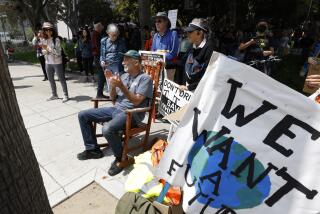Rain Nor Woe Will Not Stay Peace Trek, Marchers Vow
BARSTOW, Calif. — Organizers and participants in the Great Peace March, stopped in their tracks by foul weather and a mounting financial crisis, regrouped Wednesday and vowed to resume their trek--at least as far as Barstow--this morning.
After a day of meetings at the campsite near here and at march headquarters in Los Angeles, there was a decision by marchers to push on today. However, organizers said they must raise at least $100,000 by Friday or fold the cross-country walk for global nuclear disarmament.
At the desert campsite, Bob Alei, a communications coordinator for the marchers, said it “is not a question of whether, but how the march will go forward.”
In Los Angeles, however, David Mixner, founder/director of People Reaching Out for Peace (PROPeace), the march’s sponsoring organization, applauded the resolve, but acknowledged, “This is hard for me to say, but it is in question whether or not we will go on. The vendors are at our heels. . . . We can’t go into the desert without adequate food and medical supplies. That’s a 200-mile stretch between Barstow and Las Vegas.”
Mixner and other staff members spent the day rethinking, restructuring, scaling down and making desperate--and largely unsuccessful--efforts to raise money.
Heavy rains, high winds and cold have plagued the marchers, who have been walking an average of 15 miles a day, with colds, flu, sleeplessness, discomfort and damaged equipment for most of the past week. Monday night’s storm resulted in 12 cases of hypothermia, although no one had been reported hospitalized.
Assess Dangers
Tuesday and Wednesday were spent at the campsite about 10 miles from Barstow, as organizers and marchers began to more realistically assess the dangers facing them in the desert.
According to Torie Osborn, communications director for PROPeace in Los Angeles, health and nutrition advisers on the march have declared that existing levels of food, water and medical supplies are inadequate--especially for the desert trek. f ‘
Marcher John Curley, a former paratrooper, lectured marchers on survival tactics Tuesday, urging people, especially older marchers and those with small children, to rethink their commitment.
By Wednesday afternoon, however, few of the estimated 970 marchers had decided to leave. According to free-lance photographer Jeff Share, some marchers were taking matters into their own hands, electing leaders at the campsite, sending representatives into Barstow to approach the business community for cash and in-kind donations (and reporting a 50% success rate) and electing to send a group of parents on to Las Vegas to organize support and buy better equipment for the children. Many vowed to continue the march regardless of what organizers in Los Angeles announce.
Announced last April by Mixner, the Great Peace March was originally planned as a 255-day march of 5,000 people across America from Los Angeles to Washington. Estimates of costs for the high-tech march, and the highly sophisticated organization that was running it, ranged from $15 million to $21 million. The fund-raising efforts concentrated on merchandising deals with corporate America, outright gifts from large donors and extensive contacts and support from the entertainment world, including a massive send-off at the Los Angeles Memorial Coliseum.
When funds and marchers did not materialize in the numbers hoped for, plans began to be scaled down significantly earlier this year, including scrapping the Coliseum event in favor of a more modest, and free, departure from City Hall.
About 1,400 marchers set out from Los Angeles on March 1. PROPeace had raised about $4 million by then but was still $300,000 in debt and unable to buy liability insurance. Charges of waste and grandiose, unrealistic planning are not helping last-ditch fund-raising efforts, Osborn acknowledged, saying that by now both staff and marchers recognize that a grass-roots effort, such as is developing with marchers and people they meet is what may see them through. People, especially from churches, have been bringing food, offering showers and beds for the night and making small donations. The future of the march lies in that direction, she said.
More to Read
Sign up for Essential California
The most important California stories and recommendations in your inbox every morning.
You may occasionally receive promotional content from the Los Angeles Times.










